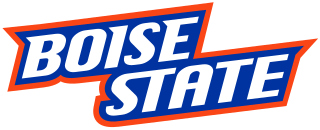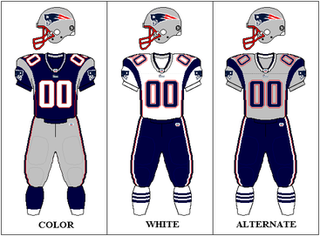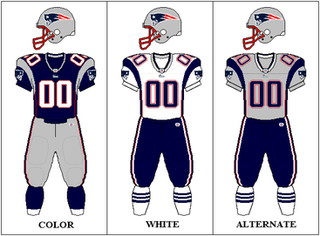
The Statue of Liberty is a trick play in American football named after, and resembling, the Statue of Liberty (Liberty Enlightening the World).

The Statue of Liberty is a trick play in American football named after, and resembling, the Statue of Liberty (Liberty Enlightening the World).
Although many variations of the play exist, the most common involves the quarterback taking the snap from the center, dropping back, and gripping the ball with two hands as if he were to throw. He then places the ball behind his back with his non-throwing hand, while pretending to throw to one side of the field with his other hand. [1] While his arm is still in motion during the fake throw, he hands the ball off behind his back to a running back or a wide receiver in motion, who runs the football to the opposite side of the field. [1] The objective is to trick the defense out of position, leaving them unable to catch up with the runner as he moves in the direction opposite to the fake.
The play is named after the positioning of the quarterback as he hands the ball off. If done correctly, he should have one hand in the air and the other at his side, resembling the pose of the Statue of Liberty. When executed properly, the Statue of Liberty is a deceptive and high-yardage play. However, the coordination of motions required is difficult, and failure may lead to a fumble, sack, or lost yardage. Additionally, disciplined defenses may be able to spot the fake.
Amos Alonzo Stagg was the first to call the play, and Stagg credited Clarence Herschberger with being the first player to run the play. The play was made popular by Fielding H. Yost during his tenure as head coach of the football team at the University of Michigan. [2]
This play was also a part of the offensive repertoire of the NFL's Los Angeles Rams teams of the mid-1970s under coach Chuck Knox.
The Northwestern Wildcats employed a direct-snap variant of this play in the 1949 Rose Bowl to run for a 45-yard touchdown in the final minutes of the game, defeating the heavily favored California Golden Bears, 20–14. [3] [4]
The Baltimore Colts ran a version of the play in December 1970. Led by 37-year-old quarterback Johnny Unitas, the Colts beat the Oakland Raiders in the 1970 AFC Championship game, 27–17. [5]
In a regular-season matchup against the Michigan Wolverines in 2007, Oregon Ducks quarterback Dennis Dixon faked a Statue of Liberty to running back Jonathan Stewart (somewhat like a bootleg) and then ran for a touchdown almost unseen. [6]
The 2007 Fiesta Bowl featured a widely reported and frequently replayed use of the play, executed by Jared Zabransky and Ian Johnson of the Boise State Broncos against the Oklahoma Sooners. [7] The play, known as "Statue Left" by the Broncos and run from a trips shotgun set, clinched Boise State a two-point conversion for the overtime victory. This bowl game is referred to as one of the closest and most exciting college football games of all time, [8] due in part to the do-or-die nature of this play.
Oklahoma saw another Statue of Liberty play in their September 6, 2008, game against the Cincinnati Bearcats. Bearcats quarterback Dustin Grutza handed off to John Goebel, but the Sooners stopped Goebel for only a short gain.[ citation needed ]
Boise State executed the same play described above nearly eight years later—once against the Wyoming Cowboys, [9] and also while facing the Arizona Wildcats in the Fiesta Bowl. [10] Both plays resulted in touchdowns for Jay Ajayi.
The New England Patriots employed an unusual variant of the play in their 2007 NFL divisional playoff game against the Jacksonville Jaguars. Strictly speaking, the play, which the Patriots called "Double Pop," [11] was actually a reverse Statue of Liberty play, in that the run, not the pass, was the fake element. Center Dan Koppen faked a direct snap to Patriots running back Kevin Faulk, causing the defense to move to stop the run; meanwhile, Patriots quarterback Tom Brady, who received the football, faked an over-the-head snap, and held the Statue of Liberty pose with his back to the defense before turning around and throwing a touchdown pass to wide receiver Wes Welker in the back of the end zone. [12]
In the 2023 NFL Wildcard playoff round, the New York Giants used a Statue of Liberty play in their 31–24 victory against the Minnesota Vikings. [13]
The execution of the Statue of Liberty play was detailed in The Brady Bunch television series in the 1973 episode "QuarterBack Sneak". [14]
In the 1995 Simpsons Halloween episode "Treehouse of Horror VI" during Bart's dream of winning the Super Bowl, Krusty the Clown calls the play but alters its design to a normal forward pass.[ citation needed ]
The hook and lateral is a trick play in American, Canadian football and indoor American football, often colloquially called the hook and ladder play.
The National Football League playoffs for the 2005 season began on January 7, 2006. The postseason tournament concluded with the Pittsburgh Steelers defeating the Seattle Seahawks in Super Bowl XL, 21–10, on February 5, at Ford Field in Detroit, Michigan.
In American football, the fumblerooski is a trick play in which the football is intentionally and stealthily placed on the ground (fumbled) by an offensive player, usually the quarterback. The offensive team then attempts to distract and confuse the defense by pretending that a ball carrier is running in one direction while another offensive player retrieves the ball from the turf and runs in a different direction, hoping to gain significant yardage before the defense realizes which player is actually carrying the football.
The halfback option play is an unorthodox play in American and Canadian football. It resembles a normal running play, but the running back has the option to throw a pass to another eligible receiver before crossing the line of scrimmage.

A flea flicker is an unorthodox play, often called a "trick play", in American football which is designed to fool the defensive team into thinking that a play is a run instead of a pass. It can be considered an extreme variant of the play action pass and an extension of the halfback option play.

In gridiron football, the holder is the player who receives the snap from the long snapper during field goal or extra point attempts made by the placekicker. The holder is set on one knee seven yards behind the line-of-scrimmage. Before the play begins, he places the hand which is closest to the placekicker on the ground in a location designated by the kicker's foot, with his forward hand ready to receive the snap. After receiving the snap, the holder will place the football on the turf, or block, ideally with the laces facing the uprights and the ball accurately placed where the backhand was initially, then balancing the ball with one or two fingers until the ball is kicked.
A trick play, also known as a gadget play, gimmick play or trickeration, is a play in gridiron football that uses deception and unorthodox tactics to fool the opposing team. A trick play is often risky, offering the potential for a large gain or a touchdown if it is successful, but with the chance of a significant loss of yards or a turnover if not. Trick plays are rarely used not only because of the riskiness, but also to maintain the element of surprise for when they are used.
Jared Zabransky is a former professional gridiron football quarterback in the National Football League and the Canadian Football League. He was signed by the Houston Texans of the NFL as an undrafted free agent in 2007 though he was never on an active roster in the NFL. He did play two seasons for the Edmonton Eskimos of the CFL in 2009 and 2010. He played college football at Boise State and was named Offensive Player of the Game in the 2007 Fiesta Bowl.

Ian Blake Johnson is a former American football running back. He played college football at Boise State.
The 2007 Tostitos Fiesta Bowl was a college football bowl game played as part of the 2006–2007 Bowl Championship Series (BCS) of the 2006 NCAA Division I FBS football season. The game was played on January 1, 2007, at its new venue, the University of Phoenix Stadium in Glendale, Arizona. The matchup pitted the Big 12 champion No. 7 Oklahoma Sooners against the WAC champion No. 9 Boise State Broncos. The contest was televised on Fox. With this broadcast, the Fiesta Bowl became the first bowl game to air on all the "big four" television networks ; the Orange Bowl became the second the following night.

The 2006 Boise State Broncos football team represented Boise State University in the 2006 NCAA Division I FBS football season. The Broncos won the Western Athletic Conference (WAC) championship with an undefeated 12–0 regular-season record, their second unbeaten regular season in the past three years. This was also Boise State's fifth consecutive season with at least a share of the WAC title, and the fourth in that period in which they went unbeaten in conference play. They became only the second team from outside the Bowl Championship Series (BCS) to play in a BCS bowl game when they faced Oklahoma in the 2007 Fiesta Bowl, defeating the Sooners in a dramatic thriller.

The 2007 season was the New England Patriots' 38th in the National Football League (NFL), their 48th overall and their eighth under head coach Bill Belichick. The Patriots improved on their 12–4 record from 2006 and won the AFC East for the sixth time in seven years by winning all 16 of their games. Starting quarterback Tom Brady won his first NFL MVP award, throwing a then-record 50 passing touchdowns. Newly acquired All-Pro wide receiver Randy Moss joined the Patriots in a trade, after a lackluster stint with the Oakland Raiders, and caught an NFL-record 23 receiving touchdowns.

The 2005 season was the New England Patriots' 36th in the National Football League (NFL), their 46th overall and their sixth under head coach Bill Belichick. With a Week 6 loss to the Denver Broncos, the Patriots failed to either improve or match their 14–2 record from last season; they finished with a 10–6 record and the division title before losing in the playoffs to the Broncos, ending their hopes of becoming the first NFL team to three peat in the Super Bowl.
NFL Classics is a series of videotaped rebroadcasts of National Football League games that air on the NFL Network. The show airs weekly during the offseason and also occasionally during the NFL season. As of the 2010, the series airs on Monday night while Super Bowl Classics airs on Friday night.
Wildcat formation describes a formation for the offense in football in which the ball is snapped not to the quarterback but directly to a player of another position lined up at the quarterback position. The Wildcat features an unbalanced offensive line and looks to the defense like a sweep behind zone blocking. A player moves across the formation prior to the snap. However, once this player crosses the position of the running back who will receive the snap, the play develops unlike the sweep.

The 2011 season was the New England Patriots' 42nd in the National Football League (NFL) and their 52nd overall. The Patriots finished the regular season at 13–3, and represented the AFC in Super Bowl XLVI. It was the seventh Super Bowl trip in franchise history, and the fifth for head coach Bill Belichick and quarterback Tom Brady.

The 2016 season was the New England Patriots' 47th in the National Football League (NFL), their 57th overall and their 17th under head coach Bill Belichick. Also, for the first time since their 2002 season, the Patriots did not play the Indianapolis Colts at all. The Patriots ended the regular season with a league-best record of 14–2 and reached a number of milestones along the way: they became the first team originating in the American Football League to reach 500 franchise wins, set the record for most consecutive division titles at eight, became the seventh team to go 8–0 on the road, set the record for most pass attempts by a team without an interception to start a season, set the record for fewest interceptions thrown by a team with just 2, and led the league for fewest points allowed (250) for the first time since the 2003 season. Belichick moved into fourth place on the list for most wins as a head coach. Brady set the record for most wins by a starting quarterback and the record for the best touchdown–interception ratio in a single season.

The Philly Special, also known as Philly Philly, was an American football trick play between Philadelphia Eagles players Corey Clement, Trey Burton, and Nick Foles on fourth-down-and-goal toward the end of the second quarter of Super Bowl LII on February 4, 2018 at U.S. Bank Stadium in Minneapolis.

The Tom Brady–Bill Belichick era, also known as the Brady–Belichick era, the New England Patriots dynasty, or the Patriots dynasty, was a sports dynasty of the New England Patriots in the National Football League (NFL) that lasted from the 2001 to the 2019 season. The dynasty is named after quarterback Tom Brady and head coach Bill Belichick, who are regarded as among the greatest in their respective positions. Belichick and Brady are consistently credited with the Patriots' success and are considered responsible for one of the sport's longest and most dominant dynasties. They are also credited with helping to create and sustain the culture around the team, dubbed the "Patriot Way", where there is an emphasis on personal accountability, consistent improvement, and a focus on team success over personal gain.